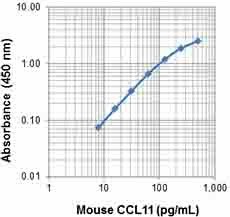- Regulatory Status
- RUO
- Other Names
- Eotaxin, eotaxin-1, small inducible cytokine subfamily A, member 11 (SCYA11)
- Ave. Rating
- Submit a Review
- Product Citations
- publications

CCL11 is a member of the CC chemokine family and was originally identified as a chemoattractant for eosinophils. In response to allergens, CCL11, which participates in a variety of allergic diseases, promotes accumulation of eosinophils. In addition, CCL11 facilitates proliferation and metastasis of tumor cells expressing the CCL11 receptor, CCR3. CCL11 has been shown to induce angiogenic responses by CCR3-positive microvascular endothelial cells.
Product DetailsProduct Details
- Source
- Mouse CCL11 (amino acids His24-Pro97, Accession# NM_011330) was expressed in E. coli.
- Molecular Mass
- The 74 amino acid recombinant protein has a predicted molecular mass of approximately 8.4 kD. The DTT-reduced protein migrates at approximately 12 kD and non-reduced protein migrates at approximately 14 kD by SDS-PAGE. The N-terminal amino acid is Histidine.
- Purity
- >95%, as determined by Coomassie stained SDS-PAGE.
- Formulation
- Lyophilized in sterile-filtered PBS, pH 7.2, containing 1% BSA, 0.09% sodium azide, and protease inhibitors.
- Concentration
- Lot-specific (to obtain lot-specific concentration and expiration, please enter the lot number in our Certificate of Analysis online tool.)
- Storage & Handling
- Unopened vials can be stored between 2°C and 8°C until the expiration date. Prior to use, reconstitute the lyophilized powder with 0.2 mL of PBS containing a carrier protein (e.g., 1% BSA, protease free), pH7.4. Re-cap vial, vortex. Allow the reconstituted standard to sit at room temperature for 15 minutes, vortex again to mix completely. The reconstituted standard stock solution can be aliquoted into polypropylene vials and stored at -70°C for up to one month. Do not re-use diluted standards. Avoid repeated freeze/thaw cycles.
- Application
-
ELISA - Quality tested
- Recommended Usage
-
Each lot of this protein is quality control tested by ELISA. For use as an ELISA standard, a standard curve comprised of doubling dilutions from 500 pg/mL to 7.81 pg/mL is suggested. It is recommended that the reagent be titrated for optimal performance.
- Application Notes
-
This CCL11 protein is useful as a standard for a mouse CCL11 sandwich ELISA, using unlabeled L403H11 antibody as capture and biotinylated Poly5222 antibody as detection.
Antigen Details
- Structure
- Chemokine
- Distribution
-
Epithelial cells, smooth muscle cells, dendritic cells, and fibroblasts
- Function
- CCL11 selectively recruits eosinophils through binding to the chemokine receptor CCR3 during allergic response. CCL11 production is upregulated in response to several proinflammatory cytokines, such as IL-4, IL-13, TNF-α, and IFN-α, produced by mast cells and Th2 lymphocytes. CCL11 has been reported to stimulate eosinophil release from bone marrow, resulting in an elevated level of circulating eosinophils.
- Interaction
- Eosinophils
- Ligand/Receptor
- CCR3
- Biology Area
- Angiogenesis, Cell Biology, Immunology, Neuroinflammation, Neuroscience
- Molecular Family
- Cytokines/Chemokines
- Antigen References
-
1. Conroy DM, et al. 2001. Respir. Res. 2:150.
2. Levina V, et al. 2009. Clin. Cancer Res. 15:2647.
3. Salcedo R, et al. 2001. J. Immunol. 166:7571.
4. Kaehler J, et al. 2006. J. Investig. Med. 54:446.
5. Hadjicharalambous C, et al. 2004. J. Allergy Clin. Immunol. 113:657.
6. Crump MP, et al. 1998. J. Biol. Chem. 273:22471. - Gene ID
- 20292 View all products for this Gene ID
- UniProt
- View information about CCL11 on UniProt.org
















Follow Us